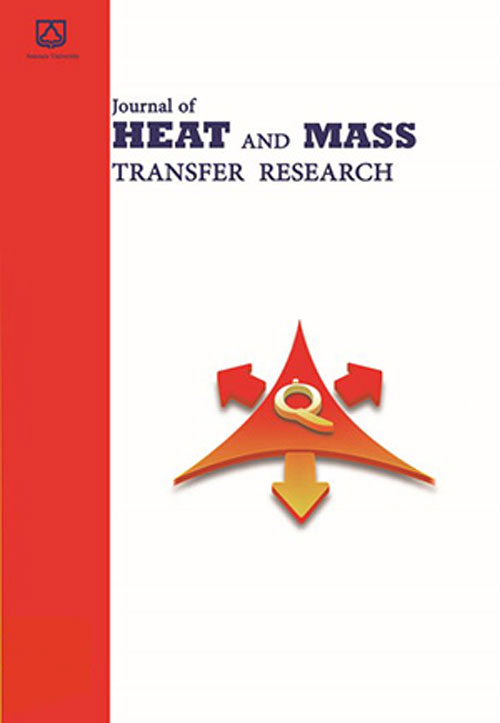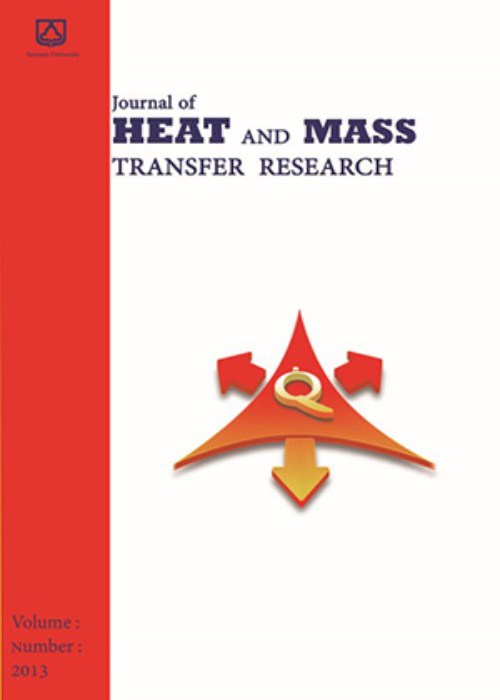فهرست مطالب

Journal of Heat and Mass Transfer Research
Volume:1 Issue: 2, Summer-Autumn 2014
- تاریخ انتشار: 1394/10/20
- تعداد عناوین: 7
-
-
Page 59Heat exchangers are one of the most important devices of mechanical systems in modern
society. Most industrial processes involve the transfer of heat and more often they require
the heat transfer process to be controlled. A heat exchanger is the heat exchanged between two media, one being cold and the other being hot. There are different types of heat exchanger, but the type which is widely used in industrial application is the shell and tube. In this study, experiments conducted based on fully replicable five-factor, five-level central composite design. Regression modelsare developed to analyse the effects of shell and tube heat exchange process parameter such as inlet temperature of hot fluid and flow rates of cold and hot fluid. The output parameters of a heat exchanger are used for analysing the direct and interactive effects of heat exchange process parameters.Keywords: Shell, Tube Heat Exchanger DOE Experiment -
Page 67This paper presents the results of a numerical study on the heat transfer performance and the removal process of fluid particles under the influence of magnetohydrodynamic mixed convection in a horizontal channel with an open cavity. The bottom wall of the cavity is heated at a constant temperature (Th) while the top wall of the channel is maintained at a relatively low temperature (Tc). Air with a uniform velocity (u0) and temperature (Tc) is introduced to the channel. The analysis is carried out for a range of values of the Grashof number (103≤Gr≤106), the Reynolds number (1≤Re≤100), and the Hartmann number (0≤Ha≤100).The results show that the heat transfer rate increases as the Grashof number increases and decreases as the Reynolds and Hartmann numbers increase. It is also shown that the removal process accelerates as the Grashof number increases and, however, decelerates as the Reynolds and Hartmann numbers increase.Keywords: Magnetohydrodynamic, Mixed convection, Channel, Fluid particles, Removal process
-
Page 75Helical coil heat exchangers are widely used in industrial applications ranging from cryogenic processes, air-conditioning, and nuclear reactors to waste heat recovery due to
their compact size and high heat transfer coefficient. In this kind of heat exchangers, flow
and heat transfer are complicated. This paper reports a numerical investigation of the influence of different parameters such as coil radius, coil pitch and diameter of tube on the characteristics of heat transfer in helical double tube heat exchangers using the well-known Fluent CFD software. Modeling of the study was implemented based on principles of heat transfer, fluid mechanics, and thermodynamics. By imposing boundary conditions and selecting of an appropriate grid, whereby the results are independent of meshing, the obtained results were compared and validated with existing experimental results in the open literature. The results indicate that heat transfer augments by increasing of the inner Dean number, inner tube diameter, curvature ratio, and by the reduction of the pitch of the heat exchanger coil.Keywords: Helical double tube, Heat exchanger, Curvature ratio, Dean number, Overall heat transfer coefficient -
Page 83Numerical study of double-diffusive natural convective heat transfer in a curved cavity filled
with a porous medium has been carried out in the current study. Polar system has been
selected as coordinate system. As a result, all equations have been discredited in r and θ
directions. Brinkmann extended Darcy model has been utilized to express fluid flow in
porous matrix in the enclosure. Smaller and larger curved walls are supposed to be hot and cold sources, respectively. Other two walls are insulated. The numerical solution has been obtained based on the finite volume methodology via staggered grid system, which will be explained in detail in its respective section. Finally, at the result section the effects of all pertinent parameters i.e. Grashof number, Lewis number, Darcy number, and Buoyancy ratio on the fluid motion and medium thermal behavior have been illustratively discussed. Results reveal that an increasing in Lewis number has a negative effect on heat transfer, while it has a positive impact on mass transfer. It is also seen that the flow intensity is increased by decreasing Lewis number. In addition, it is observed that for the aiding flow case, average Nu and Sh numbers decrease with increasing buoyancy ratio, while for opposing flow cases Nu and Sh augment with decreasing buoyancy ratio.Keywords: FVM method, Double, diffusive convection, Arc, shaped cavity, Porous media -
Page 93Compressible gas flow inside a convergent-divergent nozzle and its exhaust plume at
different nozzle pressure ratios (NPR) have been numerically studied with several turbulence models. The numerical results reveal that, the SST kω model give the best
results compared with other models in time and accuracy. The effect of changes in value of divergence half-angle (ε ) on the nozzle performance, thrust coefficient ( Cf ) and
discharge coefficient ( C d) has been investigated numerically. The predicted results show
that for a given divergence angle, the thrust coefficient (Cf ) increases by increasing nozzle pressure ratio. Also, for a given nozzle pressure ratio, the thrust coefficient increases as the nozzle divergence angle decreases. When the CD nozzle is chocking, the value of discharge coefficient is independent of nozzle pressure ratio and also for a given nozzle pressure ratio, the discharge coefficient increases as the divergence nozzle angle (ε) increases.Keywords: Numerical simulation, converging, diverging nozzle, Divergence angle, Thrust coefficient, Discharge Coefficient, Static temperature -
Page 101In this article, preparation of polypyrrole and its nanocomposites as adsorbents were
discussed and the capability of separation of copper ions from aqueous solution were studied. Polypyrrole was prepared by chemical oxidative polymerization method of pyrrole using FeCl3 as an oxidant. The removal of Cu (II) was investigated using PPy, PPy/TiO2 and PPy/TiO2/DHSNa nanocomposites. The products were investigated in terms of morphology and chemical structure with scanning electron microscopy (SEM) and Fourier-transform infrared spectroscopy (FTIR). Batch studies were performed to evaluate the influence of various experimental parameters such as pH, ion dosage and contact time. Optimum conditions for copper ions removal were found to be pH 3, ion dosage of 50 mg L-1 and the equilibrium time equals to 30 minutes. It was also found that the equilibrium adsorption isotherm was better described by Freundlich adsorption isotherm model.Keywords: Polypyrrole, Nanocomposite, Morphology, Cu (II) removal -
Page 107The thermo-hydraulic behavior of the air flow over a two dimensional ribbed channel was
numerically investigated in various rib-width ratio configurations (B/H=0.5-1.75) at different Reynolds numbers, ranging from 6000 to 18000. The capability of different
turbulence models, including standard k-ε, RNG k-ε, standard k-ω, and SST k-ω, in predicting the heat transfer rate was compared with the experimental results and it was
showed that the k-ε turbulent models best adapt with the measured data. Four main
parameters, namely, the Nusselt number, friction factor, skin friction factor, and the thermal enhancement factor were examined through the simulations. Results indicate that an increase in the Reynolds number caused the Nusselt number to increase and the friction factor to drop. It was found that the thermal enhancement factor augmented by an increase in the Reynolds number, and also, for a wider rib, i.e. at the higher the B/H ratio, a lower thermal enhancement factor was obtained.Keywords: Turbulent flow, Ribbed channel, Heat transfer, Pressure drop, Thermal, enhancement


